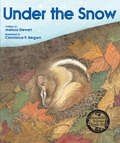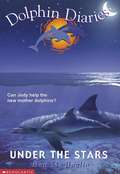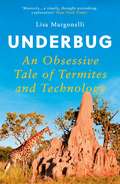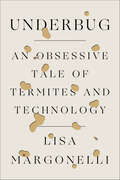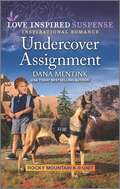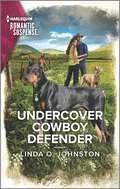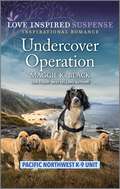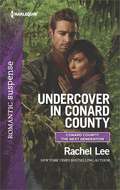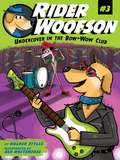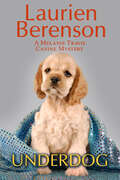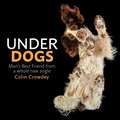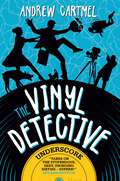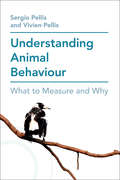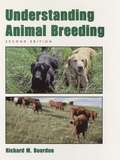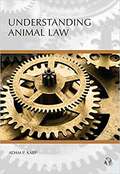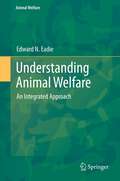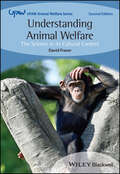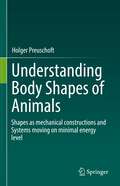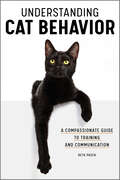- Table View
- List View
Under the Snow
by Melissa StewartA cozy look at the amazing ways animals behave and interact with their environments on a snowy day.When snow falls, we go home where it is warm and safe. But what about all those animals out there in the forests and fields? What do they do when snow blankets the ground? Award-winning science writer Melissa Stewart offers a lyrical tour of a variety of habitats, providing young readers with vivid glimpses of animals as they live out the winter beneath the snow and ice. Constance R. Bergum's glowing watercolors perfectly capture the wonder and magic that can happen under the snow.
Under the Stars (The Dolphin Diaries #4)
by Ben M. BaglioJody McGrath's dolphin dreams are coming true! Her whole family is researching dolphins - and Jody is recording all their exciting adventures in her diary. Jody is at Dolphin Haven in the Bahamas, where dolphins Bella, Misty, and Evie are about to give birth. Everyone is excited -but also worried. In the past, Evie's calves have died, and this may be her last chance to become a mother. Will her calf survive?
Under the Weather (The Adventures of Sophie Mouse #20)
by Poppy GreenSophie is jealous of the attention her brother gets from their parents while he&’s sick in this twentieth book of The Adventures of Sophie Mouse!When Sophie&’s brother, Winston, gets sick, Sophie feels bad for him…at first. But when she sees how much attention he&’s getting from their parents, she starts to feel something else: jealousy. Sophie normally loves school, but now she wishes she could stay home and play all day like Winston. But when Sophie begins to get the sniffles herself, she realizes she was much better off without them. With easy-to-read language and illustrations on almost every page, the Sophie Mouse chapter books are perfect for beginning readers!
Underbug: An Obsessive Tale of Termites and Technology
by Lisa MargonelliWho has the answer to the world&’s fuel problems? How can we bring ruined land back to life? Where do roboticists turn when they try to engineer a hive mind? Termites. Strange though it may seem, scientists are looking to these much-reviled insects as little guides to the biggest of ideas. Lisa Margonelli follows them to find out how termites could change the world. A masterpiece of popular science, Underbug touches on everything from metaphysical meditation, technological innovation and the psychology of obsession to good old-fashioned biology.
Underbug: An Obsessive Tale of Termites and Technology
by Lisa Margonelli“Margonelli takes us on a termite-guided exploration of subterranean tracts of nature, science, and robotics. The book is brimming with flair.” ―Peter Godfrey-Smith, author of Other MindsThe award-winning journalist Lisa Margonelli, national bestselling author of Oil on the Brain: Petroleum’s Long, Strange Trip to Your Tank, investigates the environmental and economic impact termites inflict on human societies in this fascinating examination of one of nature’s most misunderstood insects.Are we more like termites than we ever imagined? In Underbug, the award-winning journalist Lisa Margonelli introduces us to the enigmatic creatures that collectively outweigh human beings ten to one and consume $40 billion worth of valuable stuff annually—and yet, in Margonelli’s telling, seem weirdly familiar. Over the course of a decade-long obsession with the little bugs, Margonelli pokes around termite mounds and high-tech research facilities, closely watching biologists, roboticists, and geneticists. Her globe-trotting journey veers into uncharted territory, from evolutionary theory to Edwardian science literature to the military industrial complex. What begins as a natural history of the termite becomes a personal exploration of the unnatural future we’re building, with darker observations on power, technology, historical trauma, and the limits of human cognition.Whether in Namibia or Cambridge, Arizona or Australia, Margonelli turns up astounding facts and raises provocative questions. Is a termite an individual or a unit of a superorganism? Can we harness the termite’s properties to change the world? If we build termite-like swarming robots, will they inevitably destroy us? Is it possible to think without having a mind? Underbug burrows into these questions and many others—unearthing disquieting answers about the world’s most underrated insect and what it means to be human.
Undercover Assignment (Rocky Mountain K-9 Unit #4)
by Dana MentinkFrom USA TODAY bestselling author Dana Mentink. This K-9 will stop at nothing to keep a child safe When a little boy is threatened, Officer Daniella Vargas and K-9 partner, Zara, are assigned to pose as his nanny to uncover the culprit&’s identity. Suspecting one of the guests in his inn, widower Sam Kavanaugh&’s only option is to begrudgingly trust Daniella and Zara to help. But can they solve the case and its mysterious connection to Sam&’s late wife before it&’s too late?From Love Inspired Suspense: Courage. Danger. Faith.Rocky Mountain K-9 Unit Book 1: Detection Detail by Terri ReedBook 2: Ready to Protect by Valerie HansenBook 3: Hiding in Montana by Laura ScottBook 4: Undercover Assignment by Dana MentinkBook 5: Defending from Danger by Jodie BaileyBook 6: Tracking a Killer by Elizabeth Goddard
Undercover Cowboy Defender (Shelter of Secrets #3)
by Linda O. JohnstonShe was desperate for protection. Could she trust a man with her secret? K-9 cop Mark Martin&’s undercover assignment was to ensure security for an animal shelter, not fall for the new employee. But the shelter was a front to hide people in danger, and Luca and her young son certainly needed his help. With his connections, Mark confirmed the man stalking Luca was on the loose. How can the cowboy truly protect Luca without revealing his true identity…or his true feelings? From Harlequin Romantic Suspense: Danger. Passion. Drama.Feel the excitement in these uplifting romances, part of the Shelter of Secrets series:Book 1: Her Undercover RefugeBook 2: Guardian K-9 on CallBook 3: Undercover Cowboy Defender
Undercover Escape
by Valerie HansenA prison break gone wrong… and a fugitive out for revenge. Going undercover as a convicted killer is state trooper Rafe McDowell&’s best shot at shutting down a human trafficking ring. But when a surprise jailbreak ruins his plans and puts the prison&’s dog trainer, Hannah Lassiter, in danger, he must take her, her grandmother and their dog on the run from the mastermind behind the ring. With his fugitive target now after them, maintaining his cover is the only way to catch the criminal. But as the escalating attacks turn deadly, can he convince Hannah to trust him in order to keep them all alive?From Love Inspired Suspense: Courage. Danger. Faith.
Undercover Kitty (Second Chance Cat Mystery #8)
by Sofie RyanSarah Grayson and her capable cat, Elvis, go undercover in the newest installment of the New York Times bestselling Second Chance Cat Mysteries.Sarah and Elvis can always be found at a charming secondhand shop in the village of North Harbor, Maine. Despite the small-town setting, the daring duo often find themselves wrapped up in murder, but luckily they have help--a quirky group of senior citizens runs an amateur detective agency called Charlotte's Angels out of the store.The Angels are hired to look into who is sabotaging cat shows in the state, and they decide the best way to do that is to send Elvis the cat undercover as a contestant. But then one of the cat show volunteers is murdered just before the latest competition, and Sarah and the Angels have to catch a killer in two shakes of a cat's tail!
Undercover Mission (Alaska K-9 Unit #3)
by Sharon DunnTrapped on a ship with a killer…can her K-9 partner sniff out the clues?Undercover on a cruise ship with her K-9 dog, Alaska State Trooper Maya Rodriguez uses herself as bait to catch a murderer. And security officer David Garrison is the only person she can trust with the truth. But with a possible serial killer dead-set on taking out anyone who stands in the way, will Maya and David make it off the ship alive?USA TODAY Bestselling Author Sharon DunnFrom Love Inspired Suspense: Courage. Danger. Faith.Alaska K-9 UnitBook 1: Alaskan Rescue by Terri ReedBook 2: Wilderness Defender by Maggie K. BlackBook 3: Undercover Mission by Sharon Dunn
Undercover Operation (Pacific Northwest K-9 Unit #7)
by Maggie K. BlackRescuing valuable stolen puppies requires a K-9 officer to go deep undercover K-9 officer Asher Gilmore and trainer Peyton Burns have two tasks: rescue three stolen bloodhound puppies and expose a drug ring. To outwit the criminal masterminds, they must go undercover as married smugglers with the help of an underwater-detection dog. But infiltrating the crime ring proves more dangerous than expected, putting the operation, the puppies and their own lives at risk.From Love Inspired Suspense: Courage. Danger. Faith.Pacific Northwest K-9 Unit Book 1: Shielding the Baby by Laura ScottBook 2: Scent of Truth by Valerie HansenBook 3: Explosive Trail by Terri ReedBook 4: Olympic Mountain Pursuit by Jodie BaileyBook 5: Threat Detection by Sharon DunnBook 6: Cold Case Revenge by Jessica R. PatchBook 7: Undercover Operation by Maggie K. BlackBook 8: Snowbound Escape by Dana Mentink
Undercover in Conard County: Undercover In Conard County Deadly Fall Special Forces Seduction Dr. Do-or-die (Conard County: The Next Generation #32)
by Rachel LeeNew York Times bestselling author Rachel Lee returns to Conard County with a supercharged romance! When hunters threaten local Wyoming wildlife, investigator Kel Westin vows to catch the perpetrators. But as he's sent to work undercover with game warden Desi Jenks, Kel finds himself caught off guard by his need to protect her, too. Something tells him both he and Desi are kept awake at night by pasts that won't let go. Desi trusts no one. That includes the sexy former army ranger living in her bunkhouse, posing as a poacher to bait the ring. As a dangerous group gathers in the mountains, she must put her life in Kel's hands, a move that will change their fragile, growing bond forever...
Undercover in the Bow-Wow Club
by Walker Styles Ben WhitehouseIn this third Rider Woofson mystery, a mega rock star's instruments are stolen. Can Rider solve this musical mystery before showtime?Keep calm and rock on! Mega-superstar David Bow-Wowie is ready to rock and roll at the Bow-Wow Club until disaster strikes during his sound check! When all the instruments mysteriously disappear, Bow-Wowie is sure his music career is over. But Rider and the P.I. pack are always ready to take the stage. With easy-to-read language and illustrations on almost every page, the Rider Woofson chapter books are perfect for emerging readers.
Underdog (A Melanie Travis Canine Mystery #2)
by Laurien BerensonA dog handler&’s death unleashes a mystery: &“Laurien Berenson just keeps getting better and better.&”—Harlan Coben When Melanie Travis&’s education in breed-handling at Connecticut&’s classiest obedience school is cut short by sudden death, she smells a murder. So, with her rambunctious poodle puppy, five-year-old son, and sexy fellow breeder Sam Driver in tow, she hits the championship circuit. In this dog-eat-dog world where winning is everything, Melanie discovers that more than one suspect had a bone to pick with the victim, including a kennel owner whose secret recipe for dog biscuits isn&’t the only thing she&’s guarding. Between laps around the show ring, Melanie learns some tricks of her own. But will she learn fast enough to collar an unleashed killer who&’s begging for the dogged detective to play dead? &“With this new case, Berenson throws dog lovers a treat they will relish.&”—Pubishers Weekly &“Should appeal to dog lovers, but the smooth, unruffled prose and likable characters will attract others as well.&”—Library Journal
Underdogs
by Colin CrowdeyGet ready to see man's best friend from a whole new angle in this hilarious collection of dog photographs. Everyone loves an under dog. And now, for the first time, in this collection of brilliantly hilarious images, we get to be literally under every sort of dog. From Finn the Cockerpoo to Dora the Springer Spaniel and Dave the Bulldog, here are the funny, sweet personality-full images of dogs, along with touching stories and fascinating facts about the different breeds. These sweet, unusual images of dogs reveal their quirky personalities and are the paw-fect gift for the dog lover in your life.
Underscore: The Vinyl Detective (The Vinyl Detective)
by Andrew CartmelThe Vinyl Detective plunges into the world of Italian movie soundtrack music in his eighth adventure that is sure to delight those who love whimsical British cosy crime. Expect laughs, LPs, cats and the return of fan favourites, Nevada, Tinkler, Stinky Stanmer and more.Some of the greatest (and grooviest) music ever committed to vinyl has come out of Italy in the form of soundtracks—especially for that variety of lurid thriller known as a giallo. The maestros who composed these masterpieces include Ennio Morricone, Piero Piccioni, Armand Trovajoli… And Loretto Loconsole.No one disputes that Loconsole was a genius, but was he also a murderer?When his mistress was brutally killed in 1969, on location in Cool Britannia for a giallo called Murder in London, there wasn&’t enough evidence to prosecute him. But Loconsole died in the shadow of disgrace. Now, his granddaughter Chloë has come back to England to hire the Vinyl Detective. She wants him to find an immaculate vinyl copy of Murder in London…And to clear her grandfather&’s name.Can the Vinyl Detective and the gang—Nevada, Tinkler and Agatha—find out the truth of what happened in Swinging London more than half a century ago? And can they stay alive when there&’s someone out there who&’d prefer the secrets of the past to remain buried—and is more than willing to kill to keep it that way?
Understanding Animal Behaviour: What to Measure and Why
by Sergio Pellis Vivien PellisAll students and researchers of behaviour – from those observing freely-behaving animals in the field to those conducting more controlled laboratory studies – face the problem of deciding what exactly to measure. Without a scientific framework on which to base them, however, such decisions are often unsystematic and inconsistent. Providing a clear and defined starting point for any behavioural study, this is the first book to make available a set of principles for how to study the organisation of behaviour and, in turn, for how to use those insights to select what to measure. The authors provide enough theory to allow the reader to understand the derivation of the principles, and draw on numerous examples to demonstrate clearly how the principles can be applied. By providing a systematic framework for selecting what behaviour to measure, the book lays the foundations for a more scientific approach for the study of behaviour.
Understanding Animal Breeding (Second Edition)
by Richard M. BourdonAn experienced animal breeder, Rick Bourdon designed this book to be a modern, technologically up-to-date approach to animal breeding. Understanding Animal Breeding addresses the abstract concepts of animal breeding, presenting the necessary mathematics, but previous experience in genetics and statistics is not assumed. Well organized and readable, the book stresses application, then explains theory for an overall understanding of the material. Coverage explores the latest material on interactions and breeding objectives; performance testing; probabilities and inheritance; the Hardy-Weinberg equilibrium with multiple alleles; realized response to selection; breeding for uniformity; and biotechnology. For practicing animal breeders as well as those interested in breeding and agriculture.
Understanding Animal Law (Understanding Ser.)
by Adam KarpThis text not only covers obvious topics such as dangerous dog litigation, veterinary malpractice, wildlife law, service animals, valuation of animals, humans harmed by animals, end-of-life/euthanasia, and custody issues, but also provides analysis of other areas of law where they intersect with animal law issues, such as criminal law, estate planning, consumer protection, bankruptcy, insurance law, contractual disputes, and Section 1983.
Understanding Animal Welfare
by Edward N. EadieThis book examines the contents, influence, and potential of a personal selection of modern books published over the last fifty years that have been relevant to improving welfare. The works selected comprise three earlier classics that mainly deal with animal experimentation and intensive farming, as well as five that concentrate on specific subject areas, namely history, science, applied ethics, politics and law, that are important to protecting the welfare of animals against suffering inflicted by humans. The books are arranged in the order of their publication date, and for each one a few related works are also mentioned or discussed. This collection provides a broad understanding of animal protection issues, and provides the necessary basis for an informed and comprehensive approach to improving the welfare of animals. The books selected have been influential and they have the potential to improve animal welfare in the future.
Understanding Animal Welfare: The Science in its Cultural Context (UFAW Animal Welfare)
by David Fraser"This is a delightful book, full of interesting aspects of animal welfare. An excellent guide to the academic study of animal welfare science."—Marian Stamp Dawkins, Department of Zoology, University of Oxford Understanding Animal Welfare: The Science in its Cultural Context takes a completely fresh and thought-provoking approach. It is essential reading for anyone interested, studying or currently working in the fascinating field of animal welfare science. David Fraser places modern-day welfare issues within their historical framework by tracing the evolving ideas that led to current thinking. He also highlights some intriguing issues relating to the contradiction inherent in the term 'animal welfare science' and the practical problem of how to assess emotional states in animals. Special features: Encompasses ideas from a variety of disciplines to give a broad perspective of the topic. Discusses methods of measuring animal welfare and their strengths and limitations. Examines contemporary debates and applications of the science to policy issues. "... an impressive historical narrative of the genesis and growth of animal welfare as a scientific discipline.... The book will be invaluable for anyone involved with animal welfare issues on an academic level or those involved with the integration of these principles into current care and handling issues facing agriculture, companion, laboratory, wild, or zoo animals."—Carolyn L. Stull, PhD, Veterinary Medicine Extension, School of Veterinary Medicine, University of California, Davis "Fraser offers insights only possible from someone with his considerable experience and understanding."—Dr. Chris Sherwin, Department of Clinical Veterinary Science, University of Bristol This book is part of the UFAW/Wiley-Blackwell Animal Welfare Book Series. This major series of books produced in collaboration between UFAW (The Universities Federation for Animal Welfare), and Wiley-Blackwell provides an authoritative source of information on worldwide developments, current thinking and best practice in the field of animal welfare science and technology. For details of all of the titles in the series see www.wiley.com/go/ufaw.
Understanding Animal Welfare: The Science in its Cultural Context (UFAW Animal Welfare)
by David FraserUnderstanding Animal Welfare The essential text on understanding and improving animal welfare Understanding Animal Welfare, 2nd Edition is revised and expanded to incorporate new research and developments in animal welfare. Updated with greater accessibility in mind, the reader is guided through animal welfare in its cultural and historical context, methods of study, and applications in practice and policy. Drawing examples from farm, companion, laboratory and zoo animals, the text provides an up-to-date overview of research and its applications, while also tracing how concepts and methods have evolved over time. Readers of the second edition of Understanding Animal Welfare will also find: New developments in understanding positive animal states The importance of human actions in determining animal welfare New content on “One Welfare” How free-living wild animals are affected by human technology and climate change Originally intended for scientists and professionals, Understanding Animal Welfare has also found a home in undergraduate classrooms. It is now the essential text for students, practitioners, veterinarians, and researchers in animal welfare and related fields.
Understanding Behaviorism: Behavior, Culture, and Evolution
by William M. BaumUnderstanding Behaviorism is a classic textbook that explains the basis of behavior analysis and its application to human problems in a scholarly but accessible manner. Now in its third edition, the text has been substantially updated to include the latest developments over the last decade in behaviour analysis, evolutionary theory, and cultural evolution theory The only book available that explains behavior analysis and applies it to philosophical and practical problems, written by one of today’s best-known and most highly respected behaviorists Explores ancient concepts such as purpose, language, knowledge, and thought, as well as applying behavioural thinking to contemporary social issues like freedom, democracy, and culture Part of the new evolutionary perspective for understanding individual behavior in general and culture in particular – culminates with practical approaches to improving the lives of all humanity
Understanding Body Shapes of Animals: Shapes as mechanical constructions and Systems moving on minimal energy level
by Holger PreuschoftThis book discusses how and why animals evolved into particular shapes. The book identifies the physical laws which decide over the evolutionary (selective) value of body shape and morphological characters. Comparing the mechanical necessities with morphological details, the author attempts to understand how evolution works, and which sorts of limitations are set by selection.The book explains morphological traits in more biomechanical detail without getting lost in physics, or in methods. Most emphasis is placed on the proximate question, namely the identification of the mechanical stresses which must be sustained by the respective body parts, when they move the body or its parts against resistance.In the first part of the book the focus is on ‘primitive’ animals and later on the emphasis shifts to highly specialized mammals. Readers will learn more about living and fossil animals.A section of the book is dedicated to human evolution but not to produce another evolutionary tree, nor to refine a former one, but to contribute to answering the question: “WHY early humans have developed their particular body shape".
Understanding Cat Behavior: A Compassionate Guide to Training and Communication
by Beth PasekLearn to speak your cat's language—practical tips and compassionate training tools for ownersHave you ever wondered what your cat is trying to tell you? Understanding Cat Behavior will give you deeper insight as to why your cat does what it does—and what you can do to manage its behavior. This complete guide is packed with information and compassionate training techniques that can help you improve your relationship with your four-legged friend through a comprehensive understanding of feline behavior.From communication to playing, grooming, feeding, and beyond, you'll find helpful knowledge about cat behavior at all stages of life, from kittens to seniors and all the wonderful years in between. Here's everything you need to know to become the best cat parent you can be!Understanding Cat Behavior includes:Behavioral basics—Explore information about typical cat behavior by age, sex, and breed, as well as historical context on their evolution and domestication.Training tricks—From teaching basic commands (high five, come along, up/down, etc.) to tackling problematic cat behavior (aggression, anxiety/fear, attention-seeking, etc.), you'll find a wealth of humane training tools.Multi-cat methods—Discover practical pointers for multi-cat households, including how to introduce a new cat, keep the peace between cats and other animals, and more.Get to know your cat better with Understanding Cat Behavior.
